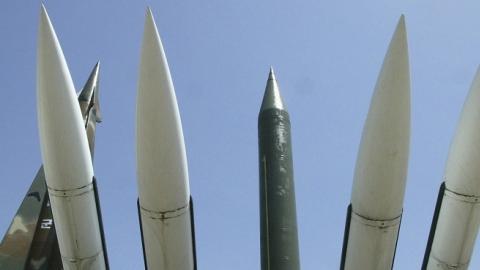The Iran deal’s implementation day is quickly approaching, which makes missile defense, especially for Israel and the United States, all the more important. Demonstrating that this reality is not lost on the Israelis, the Defense Ministry announced last week that it had successfully intercepted a long-range ballistic missile with the Arrow 3 defensive system.
According to Israel’s Defense Ministry, the trajectory of the test target was representative of the kind of long-range missile that an enemy might launch from Iran or Syria, which makes a lot of sense considering Iran continues to test missiles, flouting current U.N. Security Council Resolution 1929 that will be superseded by Resolution 2231, which just so happens to weaken missile restrictions. Although Obama officials have denounced the tests, Secretary Kerry has already made explicitly clear that missile tests, although not desirable, do not constitute a violation of the actual Iran deal. In other words, Iran can keep popping off missiles and rightly expect the deal to move forward and reward it with $150 billion of sanctions relief at the outset, which it can then use to invest in its missile program.
Last year Israel’s work on missile defense became more-well known when its Iron Dome missile defense system intercepted rockets Hamas fired into Israel. Like the United States, Israel has a layered defensive system. Various interceptors are better suited to intercept different missiles, and if one kind of interceptor misses the target, another system might intercept the missile as it descends before it hits its target. Arrow 3 will provide an "upper tier" defense for Israel.
The United States demonstrated the wisdom of this layered approach in a recent test. Several weeks ago the U.S. Missile Defense Agency conducted a complex operational missile defense test involving the Aegis SM-3 Block 1B, the THAAD defensive system, and resulted in the interception of two targets. The SM-3 IB is designed to intercept a medium-range ballistic missile in the midcourse of the missile’s trajectory. The THAAD weapon system is designed to intercept short-range missiles in the terminal phase of flight. Two test missile were fired, one short-range and one medium-range. The THAAD system successfully hit the first one, but then the medium-range target missile escaped the SM-3 IB interceptor, only to be intercepted by the THAAD system.
Some critics of missile defense might call this a failed test but if they do such critics are missing the whole point of having a layered ballistic missile defense system (BMDS). No interceptor will perform with 100 percent accuracy every time it is fired at its target. This is why there should be redundancies built into the overall system, and it is why the defensive systems should also have multiple site deployments and a high number of interceptors to shoot at would-be incoming missiles.
The implementation of the Iran deal might be inevitable, and even if a new president rightly walks back the deal and attempts to negotiate a new and better one, no one doubts that the Iranians will be steadily improving its missile program in the meantime. Missiles enable less developed countries that will never be able to catch up with the U.S. Navy or Air Force to hold the U.S. at risk. It is in Iran’s interests to invest in its already massive missile force and it makes no sense for it to halt it unless it has truly chosen to work towards peace with the West.
To date, the U.S. government has only moved forward with a BMDS designed to intercept “limited” ballistic missile threats from countries like Iran or North Korea. So far, policy-makers have intentionally declined to move forward with technologies that could hold Russian and Chinese missiles at risk, out of concern that by doing so it might prompt Russia and China to increase their offensive deployments. But this makes no sense for several reasons. One, Russia and China are already steadily investing in offensive weapons specifically designed to evade U.S. defenses. Two, Iran and North Korea are changing the nature of what was once considered “limited.” They are developing missiles with greater capabilities and in higher numbers. And three, it is far more destabilizing to intentionally remain vulnerable to a potential nuclear missile attack than to deploy the best defense possible of the American people.
Even if Iran doesn’t cheat on the Iran deal, and even if the deal really does have the effect of delaying its nuclear weapons program, the fact remains that it guarantees a flood of missiles from Iran, and then consequently, missiles from Iran’s Arab enemies. This is a new missile age, and the United States is long overdue for an update of its missile defense strategy. The Israelis don’t hesitate to build the systems their security requires. Neither should the United States.



















